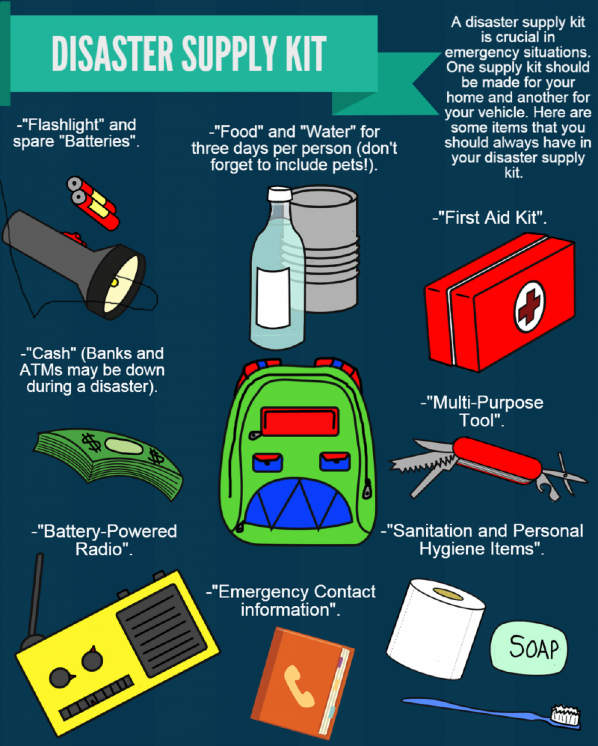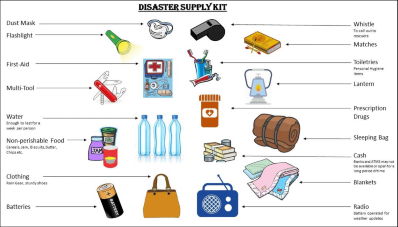Disaster Supply Kits
Having an emergency disaster supply kits will put the tools you and your family may need at your fingertips. Being prepared will keep you safe. Create a backpack for each family member based on their specific needs. If there is room, include water, food, flashlight and batteries.
 Where will you go?
Where will you go?
Your home is a great meeting place but you or another family member may experience roads are blocked, bridges out or an evacuation is in effect? Recommend including a 2nd and 3rd rendezvous point -- friend or family member's home in another part of town, work location, etc.
How Will You Reconnect?
In a disaster your landline or cell phone service may be down. Establish a communication plan if you are separated:
-
Long-range walkie-talkies
-
Give each family member the contact information (in writing) for someone outside local area. This person(s) can act as an emergency communication hub.
Can You Be Self-Sufficient for 3-5 Days?
Your Disaster Supply Kit should include basic supplies for three to five days. If a family members travels a few miles from home each day they should have an additional kit in their car or workplace. Here's a short list:
-
Non-perishable food
-
Water (three gallons per person per day)
-
Eating utensils, plates and bowls
-
Paper towels
-
Hand sanitizer
-
Pet food
-
Dust mask to help filter contaminated air and plastic sheeting and duct tape to shelter-in-place
-
Cash
-
Scissors
-
First aid kit
-
Family members’ medications (5 days worth)
-
Toiletries, including feminine products
-
Portable battery-operated AM/FM radio
-
Flashlights
-
Extra Batteries for radio and flashlights
-
Comfortable walking shoes
-
Signaling devices: flares, mirror, whistle
-
Sleeping bags
-
Copies of important family documents
-
Regionally appropriate items such as sunscreen, bug repellent, cold weather apparel.
-
Store in waterproof bags inside easy-to-carry containers
-
If you can't afford to purchase all the items above at once, purchase a few each week until you have everything you need.
 Are You Prepared to Administer First Aid?
Are You Prepared to Administer First Aid?
In disaster situations Emergency Responders and/or Services may be unavailable; basic first aid skills are essential. Typical injuries are broken bones, burns, cuts, deep wounds, sprains, etc. First Aid Training will keep you calm and confident to handle the emergency situation.
How Well Does Your Plan Work?
The final and most important step -- test your plan.
-
Bring your family together to discuss scenarios (kids at school, parents at work, etc.)
-
Ask each family member to bring their Disaster Supply Kit to the meeting to review all the items in each kit. Discuss what may be missing.
Best way to test your plan; imagine:
-
your phones don't work
-
there is no electricity
-
there is no Internet
Spend a weekend living off your emergency supply kit (replenish items afterward).
You may decide to invest in additional flashlights, headlamps or even a camping toilet! Figure out where the shut off switches are for your home.
Did you remember items your pets will need?
Be safe, stay alert and be kind.
|
MacKoul
Pediatrics
206 SE 16th Place
Cape Coral, FL 33990
239.573.2001
office
239.573.2006 fax
|
HOURS
Monday: 8AM - 5PM
Tuesday: 8AM - 5PM
Wednesday: 8AM - 5PM
Thursday: 8AM - 5PM
Friday: 8AM - 5PM
Saturday: 8AM - Noon
(Sat: Sick Patients ONLY)
Sunday: CLOSED |
Proudly Serving
Cape Coral, Florida
Matlacha, Florida
Pine Island, Florida
Fort Myers, Florida
North Fort Myers, Florida
Punta Gorda, Florida
Port Charlotte, Florida
Estero, Florida
Bonita Springs, Florida
|
|
Subject to change without notice
.
Copyright. All rights reserved.

![[IMAGE]](http://static.mackoulpediatrics.com/images/858_ncqa_logo_centered.png)


